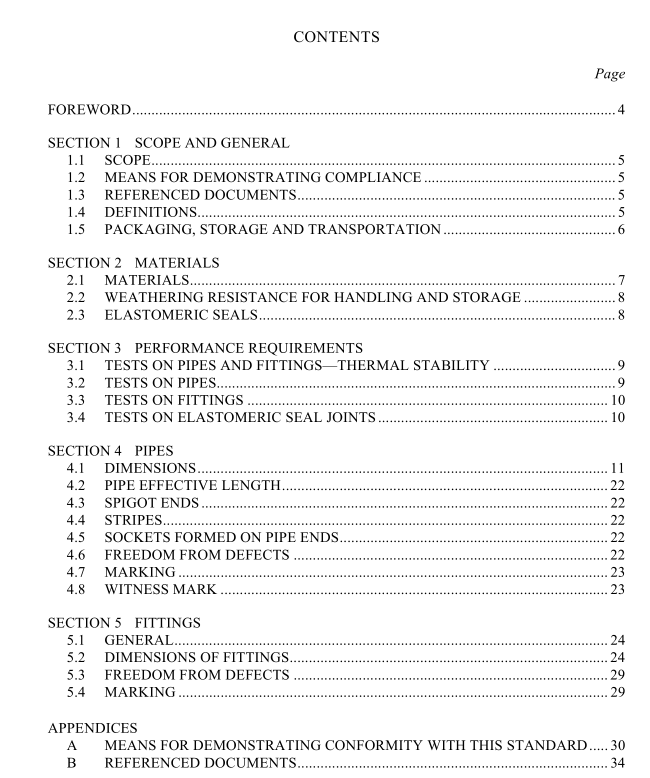AS NZS 5065-2005 pdf download – Polyethylene and polypropylene pipes and fittings for drainage and sewerage applications

AS NZS 5065-2005 pdf download – Polyethylene and polypropylene pipes and fittings for drainage and sewerage applications
2.1 MATERIALS
2.1.1 Composition requirements for PE and PP
Pipes and fittings shall be manufactured from matcrials containing antioxidants,UVstabilizers and pigments necessary for their manufacture into pipes and fittings.
2.1.2 Stripe and jacket materials
Striping and jacket compounds shall be fully pre-compounded and shall comply with therequirements of Clauses 2.1.3 to 2.1.9.
2.1.3 Black PE and PP compounds
When determined in accordance with ISO 6964, black PE and PP compounds shall contain2.25+0.25% by mass of carbon black.
When determined in accordance with ASTM D3849 or equivalent, the average particle sizeof carbon black shall be in the range of 10 nm to 25 nm.
When determined in accordance with Appendix B of AS/NZS 4131, the toluene extract ofcarbon black shall be not greater than 0.1%.
2.1.4 Volatile content
When compounds are tested in accordance with Annex A of ISO 4437, the volatile contentshall be not greater than 350 mg/kg at the time of manufacture.
2.1.5 Melt mass-flow rate (MFR)
When determined in accordance with ISO 1133,MFR values of materials taken from pipesand fittings shall be as follows:
(a)PEpipes and injection moulded fittings— 0.2 g/10 min ≤ MFR ≤ 1.1 g/10 min(temperature 190°C; loading mass 5.0 kg, condition T).
(b)PErotational mouldedfittings—1.6 g/10 min ≤ MFR ≤ 3 g/10 min (temperature
190°C; loading mass 5.0 kg, condition T).
(c)PP—MRF ≤ 1.5 g/10 min (temperature 230°C; loading mass 2.16 kg, condition M).2.1.6 Thermal stability of PE compounds
PE compounds shall contain antioxidants,such that when determined,using oxygen,inaccordance with ISO 11357-6, the oxidation induction time at a test temperature of 20ocshall be in accordance with Table 2.1 or a demonstrated equivalent time at highertemperature.
Other test methods may be used provided that they can be demonstrated to give an accuracyof the same or higher degree than that given in Iso 11357-6.
2.1.7 Environmental stress cracking resistance (ESCR) of PE compounds
PE compounds materials or material taken from the pipe or fitting,when tested inaccordance with AS/NZS 1462.25, at a stress of 15% of actual yield stress, as derived inaccordance with Clause 2.1.8,shall not fail in less than 24 h. Compounds that comply withAS/NZS 4131 may be deemed to comply with this Clause.
2.1.8 Tensile properties of PE compounds
When PE compound is tested in accordance with AS 1145.2 at a strain rate of 5 mm/min,the minimum values of tensile properties shall be established.
2.1.9 Internal pressure resistance of PP compounds
PP copolymer (PP-B) and PP homopolymer (PP-H) materials shall comply with ISO 8773.2.1.10 Decohesive resistance of jackets and stripes
Jacketed and striped pipe shall be tested in accordance with ISO 13954. Decohesionbetween jacket or stripe and parent pipe shall not occur over more than 30% of the socketfusion zone as defined in Table 5.4.
2.2 WEATHERING RESISTANCE FOR HANDLING AND STORAGE
The weathering resistance test shall apply to all non-black compounds with less than 0.2%by mass of HALS, including those used for jackets and stripes.Compounds complying withAS/NZS 4131 shall be deemed to comply with this Clause.
The weathering resistance,including resistance to ultraviolet light radiation, of PE or PPcompounds determined in accordance with AS/NZS 4131,Appendix C, on samples exposedto at least 3.5 GJ/m2total global radiation shall be such that—
(a)the thermal stability has been established as above; and
(b)for PE, the mean elongation at break is 2350%,and for PP, the mean clongation at
break shall not change by more than 50% of the value of the unexposed material.
NOTE: The intent of the weathering test is to provide assurance of resistance to weatheringencountered during storage and transport of pipe. The test does not provide similar assurance forinstallations exposed to the elements long term. Reference should be made to AS 1745.2 fortypical incident energy at various sites around Australia.
2.3ELASTOMERIC SEALS
The elastomeric seals shall comply with AS 1646.









